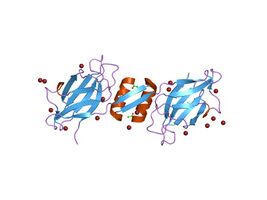Biology:Fungal immunomodulatory protein
| Fungal immunomodulatory protein | |||||||||||
|---|---|---|---|---|---|---|---|---|---|---|---|
 | |||||||||||
| Identifiers | |||||||||||
| Symbol | FIP | ||||||||||
| Pfam | PF09259 | ||||||||||
| InterPro | IPR015339 | ||||||||||
| |||||||||||
Fungal immunomodulatory proteins (FIPs) are a type of functional compound (other compounds include polysaccharides and triterpenoids) found in various species of fungi. FIPs are part of the immunoglobulin (ig) family, which are structurally similar to human antibodies, and can interact with human peripheral blood mononuclear cells (PBMCs), causing these cells to secrete different types of hormones and regulate cellular activity.[1]
History
The first FIP was discovered in 1989 by Japanese scientist Kohsuke Kino et al. from the water extract of the mycelium of Ganoderma lucidum, and was named Ling Zhi-8 (LZ-8).[2]
From then on, researchers have identified numerous structurally similar proteins from various types of fungi that also share a high degree of genetic similarity as well as physiological activities, and thus coined the term fungal immunomodulatory protein (FIP).[3]
Members of the FIP family
Currently known FIPs[3] are listed below:
- LZ-8 from G. lucidum
- LZ-9 from G. lucidum[4]
- FIP-gts from G. tsugae[5]
- FIP-gsi (NCBI DNA Accession number AY987805; Protein Accession number AAX98241) from G. sinensis
- GMI (FIP-gmi) (NCBI GI Accession number 310942694; Protein Data Bank Accession number 3KCW_A) from G. microsporum
- FIP-tve (NCBI DNA Accession number XM_008037967; Protein Accession number XP_008036158) from Trametes versicolor
- FIP-pcp from Poria cocos[6]
- FIP-fve (NCBI DNA Accession number GU388420; Protein Accession number ADB24832) from Flammulina velutipes
- FIP-vvo from Volvariella volvacea[7]
- FIP-aca from Antrodia camphorate[8]
- FIP-lrh from Lignosus rhinocerotis[9]
References
- ↑ "New advances and potentials of fungal immunomodulatory proteins for therapeutic purposes". Critical Reviews in Biotechnology 40 (8): 1172–1190. December 2020. doi:10.1080/07388551.2020.1808581. PMID 32854547.
- ↑ "Isolation and characterization of a new immunomodulatory protein, ling zhi-8 (LZ-8), from Ganoderma lucidium". The Journal of Biological Chemistry 264 (1): 472–478. January 1989. doi:10.1016/S0021-9258(17)31282-6. PMID 2909532.
- ↑ 3.0 3.1 "Current Understanding of the Structure and Function of Fungal Immunomodulatory Proteins". Frontiers in Nutrition 7: 132. 2020. doi:10.3389/fnut.2020.00132. PMID 33015115.
- ↑ "In vivo screening of five phytochemicals/extracts and a fungal immunomodulatory protein against colibacillosis in broilers". Avian Pathology 42 (3): 235–247. 2013. doi:10.1080/03079457.2013.780121. PMID 23627727.
- ↑ "Dimerization of the N-terminal amphipathic alpha-helix domain of the fungal immunomodulatory protein from Ganoderma tsugae (Fip-gts) defined by a yeast two-hybrid system and site-directed mutagenesis". The Journal of Biological Chemistry 272 (32): 20044–20048. August 1997. doi:10.1074/jbc.272.32.20044. PMID 9242675.
- ↑ "A novel immunomodulatory protein from Poria cocos induces Toll-like receptor 4-dependent activation within mouse peritoneal macrophages". Journal of Agricultural and Food Chemistry 57 (14): 6129–6139. July 2009. doi:10.1021/jf9011399. PMID 19548679.
- ↑ "Fip-vvo, a new fungal immunomodulatory protein isolated from Volvariella volvacea". The Biochemical Journal 323 ( Pt 2) (Pt 2): 557–565. April 1997. doi:10.1042/bj3230557. PMID 9163352.
- ↑ "Macrophage mediated anti-proliferation effects of Anthodia camphorata non-polysaccharide based extracts on human hepatoma cells". Bioscience, Biotechnology, and Biochemistry 75 (4): 624–632. 2011. doi:10.1271/bbb.100559. PMID 21512226.
- ↑ "Characterisation of a New Fungal Immunomodulatory Protein from Tiger Milk mushroom, Lignosus rhinocerotis". Scientific Reports 6: 30010. July 2016. doi:10.1038/srep30010. PMID 27460640. Bibcode: 2016NatSR...630010P.
 |

